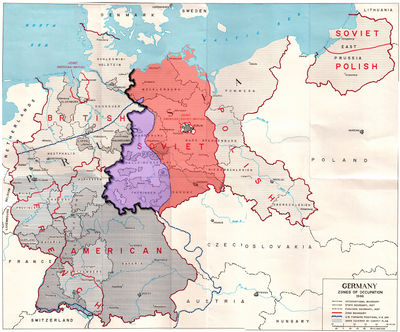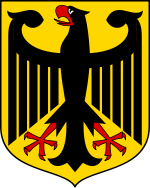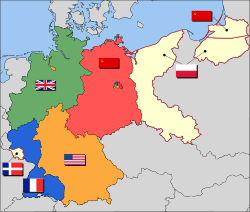Allied-occupied Germany
|
|||||||||||||||||||||||||||||||||||||||||||||||||||||||||||||||||
The Allied powers who defeated Nazi Germany in World War II divided the country west of the Oder-Neisse line into four occupation zones for administrative purposes during 1945–1949. In the closing weeks of fighting in Europe, American forces had pushed beyond the previously agreed boundaries for the future zones of occupation, in some places by as much as 200 miles. The line of contact between Soviet and American forces at the end of hostilities was temporary. After two months in which they had held areas that had been assigned to the Soviet zone, American forces withdrew in the first days of July 1945.[1] Some have concluded that this was a crucial move that persuaded the Soviet Union to allow American, British, and French forces into their predesignated zones in Berlin, which occurred at roughly the same time (July 1945), although the need for intelligence gathering (see Operation Paperclip) may also have been a factor.
Contents |
The Zones of Occupation

American Zone of Occupation
The American zone consisted of Bavaria and Hesse in Southern Germany, and the northern portions of the present-day German state of Baden-Württemberg. The ports of Bremen (on the lower Weser River) and Bremerhaven (at the Weser's estuary into the North Sea) were also placed under the US control because of the American request to have toeholds in Northern Germany. The headquarters of the American military government was the former IG Farben Building in Frankfurt, (Frankfurt am Main).
Beginning in May 1945, US combat troops were shipped back to the United States based on the Advanced Service Rating Score. Some experienced officers and NCOs were to be sent to the Pacific Theater whereas those that were eligible were discharged. The rules were relaxed following VJ Day in August 1945.
British Zone of Occupation
In July 1945, when the British forces withdrew from all German territories they had conquered that were provided to be occupied by another Ally, the British military government ceded some smaller sections of their zone to the Soviet Zone, specifically the Hanoverian Amt Neuhaus and some Brunswickian exclaves and fringes (e.g. County of Blankenburg). Within its zone the British military government restituted the traditional German state of Hamburg (but in borders drawn by the Nazis in 1937) and established the new states of Schleswig-Holstein (formed in 1946 from the Prussian Province of the same name), Lower Saxony (a merger of the restituted Free States of Brunswick, Oldenburg and Schaumburg-Lippe with the Prussian province of Hanover in 1946) and North Rhine-Westphalia (a merger of the restituted Free State of Lippe and the northern part of the Prussian provinces of the Rhineland (with the southern part under French occupation) and Westphalia in 1946–47). In 1947 by a redeployment the restituted traditional German state of Bremen became an exclave of the US Zone of Occupation within the British zone. The military government, officially Control Commission for Germany – British Element, headquartered in Bad Oeynhausen.
French Zone of Occupation
Initially, despite being one of the Allied powers, the French were not to be granted an occupation zone due to concerns over the great historical animosity between France and Germany, as well as the smaller role played by the French within the alliance. However, throughout the war, Charles de Gaulle, leader of the Free French forces, continuously argued for France's role in the post-war world; eventually, both the British and the Americans agreed to cede small portions of their respective zones to France. This arrangement resulted in the French zone consisting of two non-contiguous areas along the border with France creating a quadripoint with the US zone on the Rhine. The headquarters of the French military government was in Baden-Baden.
The Saargebiet, an economically important area due to its rich coal deposits, was enlarged and in 1947 turned into the Saar protectorate. It was a nominally independent state, but its economy was integrated into the French economy.
Soviet Zone of Occupation


The Soviet occupation zone incorporated Thuringia, Saxony, Saxony-Anhalt, Brandenburg and Mecklenburg-Vorpommern. The Soviet Military Administration in Germany was headquartered in Berlin-Karlshorst.
Berlin
While located wholly within the Soviet zone, because of its symbolic importance as the nation's capital and seat of the former Nazi government, the city of Berlin was jointly occupied by the Allied powers and subdivided into four sectors. Berlin was not considered to be part of the Soviet zone.
Governance and the emergence of two German states
The original Allied plan to govern Germany as a single unit through the Allied Control Council broke down in 1946–1947 due to growing tensions between the West and the Soviet Union, and was never fully implemented. In practice, each of the four occupying powers wielded government authority in their respective zones and carried out different policies toward the population and local and state governments there. A uniform administration of the western zones evolved, known first as the Bizone (the American and British zones merged as of 1 Jan 1947) and later the Trizone (after inclusion of the French zone). The complete breakdown of east-west allied cooperation and joint administration in Germany became clear with the Soviet imposition of the Berlin Blockade that was enforced from June 1948 to May 1949. The three western zones were merged to form the Federal Republic of Germany in May 1949, and the Soviets followed suit in October 1949 with the establishment of the German Democratic Republic (GDR).
In the west, the occupation officially continued until May 5, 1955, when the Deutschlandvertrag ("Germany Treaty") entered into force. However, upon the creation of the Federal Republic in May 1949, the military governors were replaced by civilian high commissioners, whose powers lay somewhere between those of a governor and those of an ambassador. When the Deutschlandvertrag became law, the occupation officially ended, the western occupation zones ceased to exist, and the high commissioners were replaced by normal ambassadors.
A similar situation occurred in East Germany. The GDR was founded on October 7, 1949. On October 10, the Soviet Military Administration in Germany was replaced by the Soviet Control Commission, although limited sovereignty was not granted to the GDR government until November 11, 1949. After the death of Joseph Stalin in March 1953, the Soviet Control Commission was replaced with the office of the Soviet High Commissioner on May 28, 1953. This office was abolished (and replaced by an ambassador) and (general) sovereignty was granted to the GDR, when the Soviet Union concluded a state treaty (Staatsvertrag) with the GDR on September 20, 1955.
Despite the grants of general sovereignty to both German states in 1955, full and unrestricted sovereignty under international law was not enjoyed by any German government until after the reunification of Germany in October 1990. In fact, the provisions of the Treaty on the Final Settlement with Respect to Germany, also known as the "Two-plus-Four Treaty," granting full sovereignty to Germany did not become law until 15 March 1991, after all of the participating nations had ratified the treaty.
A 1956 plebiscite ended the French administration of the Saar protectorate within the former French occupation zone and it joined the Federal Republic as the Saarland on January 1, 1957.
Officially, the city of Berlin was not part of either state and continued to be under Allied occupation until the reunification of Germany in October 1990. For administrative purposes, the three western sectors of Berlin were merged into the entity of West Berlin. The Soviet sector became known as East Berlin and while not recognized by the Western powers as a part of East Germany, GDR declared it its capital (Hauptstadt der DDR).
The German territory east of the Oder-Neisse line (Pomerania, Neumark, Silesia and East Prussia) was annexed by Poland and the Soviet Union. The northern portion of East Prussia became the newly-formed Kaliningrad Oblast, part of the Russian SFSR. All territory annexed by Germany during the war (from France, Belgium, Luxemburg, Yugoslavia, Austria, Czechoslovakia, Poland and Lithuania) was returned to those countries or annexed by the Soviet Union.
Occupation policy

In order to impress the German people with the Allied opinion of them, a strict non-fraternization policy was adhered to by General Eisenhower and the War Department. However, thanks to pressure from the State Department and individual US congressmen this policy was lifted in stages. In June 1945 the prohibition against speaking with German children was made less strict. In July it became possible to speak to German adults in certain circumstances. In September the whole policy was completely dropped in Austria and Germany.
By December 1945 over 100,000 German civilians were interned as security threats and for possible trial and sentencing as members of criminal organizations.
The food situation in occupied Germany was initially very dire. By the spring of 1946 the official ration in the U.S. zone was no more than 1275 calories per day, with some areas probably receiving as little as 700. Some U.S. soldiers used this desperate situation to their advantage, exploiting their ample supply of food and cigarettes (the currency of the black market) as what became known as frau bait (The New York Times, 25 June 1945). Some Americans still felt the girls were the enemy, but used them for sex nevertheless.[2]
The often destitute mothers of the resulting children usually received no child support. In the earliest stages of the occupation, U.S. soldiers were not allowed to pay maintenance for a child they admitted having fathered, since to do so was considered "aiding the enemy". Marriages between white U.S. soldiers and Austrian women were not permitted until January 1946, and with German women until December 1946.[2]
Relationships between black American soldiers and German women entailed a greater degree of risk for both partners. For many white soldiers sex between black men and white women was intolerable, even if the women were the enemy. Black soldiers thus risked suffering reprisals at the hands of white soldiers if they were suspected of seeking or having sex with German women. The children of black American soldiers, commonly called Negermischlinge ("Negro half-breeds"), comprising about 3 percent of the total number of children fathered by GIs, were particularly disadvantaged because of their inability of conceal the foreign identity of their father. Black soldiers were reluctant to admit to fathering Negermischlinge since this would invite reprisals, and even in the cases where a soldier was willing to take responsibility he was prohibited from doing so by the U.S. Army which until 1948 prohibited interracial marriages.[3] The mothers of Negermischlinge would often face particularly harsh ostracization. A considerable proportion of Negermischlinge were abandoned, some were even murdered by their mothers.
Between 1950 and 1955 the Allied High Commission for Germany prohibited "proceedings to establish paternity or liability for maintenance of children."[3] Even after the lifting of the ban West German courts had little power over American soldiers.
In general, the British authorities were less strict than the Americans about fraternization, and the French and Soviets more.
While Allied servicemen were ordered to obey local laws while in Germany, soldiers could not be prosecuted by German courts for crimes committed against German citizens except as authorized by the occupation authorities. Invariably, when a soldier was accused of criminal behavior the occupation authorties preferred to handle the matter within the military justice system. This sometimes led to harsher punishments than would have been available under German law - in particular, U.S. servicemen could be executed if court-martialed and convicted of rape.
Expulsion policy
The Potsdam conference, where the victorious Allies drew up plans for the future of Germany, noted in article XIII of the Potsdam Agreement on 1 August 1945 that "the transfer to Germany of German populations (...) in Poland, Czechoslovakia and Hungary will have to be undertaken"; "wild expulsion" was already going on.
Hungary, which had been allied with Germany and where no expulsions had as yet taken place and in addition population was opposed to an expulsion of the German minority, tried to resist this, but in the end had to yield to the pressure exerted mainly by the Soviet Union but also by the Allied Control Council.[4] Of the millions expelled from former eastern territories of Germany, Poland, Czechoslovakia, Hungary and elsewhere, when they were not used for forced labor, over a period of years they were sent to the occupation zones of UK, USA, and USSR, who agreed in the Potsdam Agreement to absorb the post-war expellees into their zones, where many remained in refugee camps for a long time.
France wasn't invited to the Potsdam Conference. As a result, it took its own liberties to approve some decisions of the Potsdam Agreements and to dismiss others. As to the question of the post-war expellees, France maintained the position that it didn't approve post-war expulsions and that therefore it was not responsible to accommodate and nourish the destitute expellees in its zone. Whilst the few war-related refugees, who had reached the area to become the French zone before July 1945, were taken care of, the French military government for Germany refused to absorb post-war expellees deported from the East into its zone. In December 1946, the French military government for Germany absorbed into its zone German refugees from Denmark, where 250,000 Germans had found a refuge from the Soviets by sea vessels between February and May 1945.[5] These clearly were war-related refugees from the eastern parts of Germany however, and not post-war expellees.
The military governors and commissioners
| History of Germany | |
|---|---|
 This article is part of a series |
|
| Early History | |
| Germanic peoples | |
| Migration Period | |
| Frankish Empire | |
| Medieval Germany | |
| East Francia | |
| Kingdom of Germany | |
| Holy Roman Empire | |
| Eastward settlement | |
| Early Modern period | |
| Sectionalism | |
| 18th century | |
| Kingdom of Prussia | |
| Unification of Germany | |
| Confederation of the Rhine | |
| German Confederation & Zollverein | |
| German Revolutions of 1848 | |
| North German Confederation | |
| The German Reich | |
| German Empire | |
| World War I | |
| Weimar Republic Saar, Danzig, Memel, Austria, Sudeten |
|
| Nazi Germany | |
| World War II Flensburg government |
|
| Germany since 1945 | |
| Occupation + Ostgebiete | |
| Expulsion of Germans | |
| FRG, Saar & GDR | |
| German reunification | |
| reunified Germany | |
| Topics | |
| Military history of Germany | |
| Territorial changes of Germany | |
| Timeline of German history | |
|
Germany Portal |
American Zone
- Military governors
- May 8, 1945 – November 10, 1945 Dwight D. Eisenhower
- November 11, 1945 – November 25, 1945 George S. Patton (acting)
- November 26, 1945 – January 5, 1947 Joseph T. McNarney
- January 6, 1947 – May 14, 1949 Lucius D. Clay
- May 15, 1949 – September 1, 1949 Clarence R. Huebner (acting)
- High commissioners
- September 2, 1949 – August 1, 1952 John J. McCloy
- August 1, 1952 – December 11, 1952 Walter J. Donnelly
- December 11, 1952 – February 10, 1953 Samuel Reber (acting)
- February 10, 1953 – May 5, 1955 James B. Conant
British Zone
- Military governors
- May 22, 1945 – April 30, 1946 Sir Bernard Law Montgomery
- May 1, 1946 – October 31, 1947 William Sholto Douglas
- November 1, 1947 – September 21, 1949 Sir Brian Hubert Robertson
- High commissioners
- September 21, 1949 – June 24, 1950 Sir Brian Hubert Robertson
- June 24, 1950 – September 29, 1953 Sir Ivone Kirkpatrick
- September 29, 1953 – May 5, 1955 Sir Frederick Hoyer Millar
French Zone
- Military commander
- May 1945 – July 1945 Jean de Lattre de Tassigny
- Military governor
- July 1945 – September 21, 1949 Marie-Pierre Koenig
- High commissioner
- September 21, 1949 – May 5, 1955 André François-Poncet
Soviet Zone
- Military commander
- April 1945 – June 9, 1945 Georgy Konstantinovich Zhukov
- Military governors
- June 9, 1945 – April 10, 1946 Georgy Konstantinovich Zhukov
- April 10, 1946 – March 29, 1949 Vasily Danilovich Sokolovsky
- March 29, 1949 – October 10, 1949 Vasily Ivanovich Chuikov
- Chairman of the Soviet Control Commission
- October 10, 1949 – May 28, 1953 Vasily Ivanoivich Chuikov
- High commissioners
- May 28, 1953 – July 16, 1954 Vladimir Semyonovich Semyonov
- July 16, 1954 – September 20, 1955 Georgy Maksimovich Pushkin
See also
- Allied-administered Austria
- Interzonal traffic
- Werwolf (Short-lived resistance movement)
- History of Germany since 1945
- Advanced Service Rating Score
References
- ↑ What Is to Be Done? TIME Magazine, July 9, 1945
- ↑ 2.0 2.1 Perry Biddiscombe: Dangerous Liaisons: The Anti-Fraternization Movement in the U.S. Occupation Zones of Germany and Austria, 1945–1948, Journal of Social History 34.3 (2001) 611–647
- ↑ 3.0 3.1 Children of the Enemy by Mary Wiltenburg and Marc Widmann, Der Spiegel, 2007-01-02
- ↑ [1]
- ↑ Report of the Central Archive of the State of Rhineland-Palatinate on the absorption of German refugees
External links
|
||||||||||||||||||||||
.svg.png)

